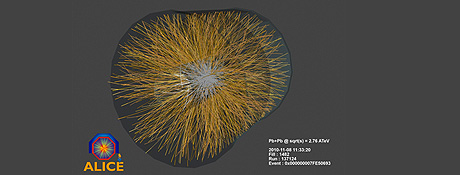Collision of Heavy Atomic Nuclei: Heidelberg Physicists Evaluate First LHC Data
17 November 2010

Illustration: ALICE-Team
The Large Hadron Collider (LHC) at the CERN European Research Centre in Geneva, the largest particle accelerator in the world, has for the first time accelerated heavy lead ions for highest-energy collisions. This means that ALICE, one of the four major international experiments going on at the LHC, has successfully negotiated the transition from proton-proton collisions to physics with heavy ions. Scientists from Heidelberg University have been centrally involved in the 15-year preparatory stage, as they will be in the data evaluation phase starting up soon. Initial research results are expected in the next few days, says Prof. Dr. Johanna Stachel of Heidelberg University’s Institute of Physics. She is in charge of the ALICE priority research project of the Federal Ministry of Research and Education (BMBF).

The research undertaken in the framework of ALICE is geared to the collision of heavy atomic nuclei. The collision of lead atomic nuclei is designed to reproduce, for infinitesimal time periods, the extremely hot and dense plasma state of matter made up of quarks and gluons as it existed for a fraction of a second immediately after the Big Bang. Prof. Stachel explains that the collision of two such nuclei produces tens of thousands of particles that scientists can now measure and characterise precisely. “This marks the advent of a new era in particle physics research,” she comments.
Of the over 100 researchers from Germany involved in the international ALICE collaboration about 30 come from Heidelberg, making it the location with the largest university contingent participating in the project. Representatives from the Faculty of Physics and Astronomy of Heidelberg University are Prof. Stachel and Prof. Dr. Norbert Herrmann from the Institute of Physics and Prof. Dr. Udo Kebschull of the Kirchhoff Institute for Physics. The Heidelberg researchers have had a major hand in the construction of detector components. “And now we’re playing a leading role in the scientific evaluation of the data,” says Prof. Stachel.
The ALICE detector is 25 m long, 16 m wide and 16 m high. It functions like a three-dimensional camera and supplies snapshots of collisions between heavy ions. The resolution is 600 million pixels, corresponding to 750 megabytes of information. At a read-out speed of 17.5 terabytes/sec, several thousand events can be passed on for analysis in one second.
ALICE consists of a number of individual components. German researchers are in charge of three of them. The first is the Time Projection Chamber enveloping the collision zone up to a radial distance of 2.5 metres along a length of 5 metres. The second is the Transition Radiation Detector (TRD), the next component towards the outside. Prof. Stachel is TRD project leader. The third project is the so-called High Level Trigger, a novel high-performance computer system capable to analyse within fractions of a second the vast amounts of data generated by every ALICE event.
The ALICE priority research project funded by the Federal Ministry of Education and Research is a cross-regional network of outstanding researchers, including scientists from German university groups in Darmstadt, Frankfurt, Heidelberg, and Münster, plus the GSI Helmholtz Centre for Heavy Ion Research in Darmstadt as well as the Fachhochschulen Cologne and Worms.
For more information, go to http://aliceinfo.cern.ch/Collaboration/index.html .
Contact
Prof. Dr. Johanna Stachel
Institute of Physics
phone: +49 6221 549224
stachel@physi.uni-heidelberg.de
Communications and Marketing
Press Office, phone: +49 6221 542311
presse@rektorat.uni-heidelberg.de

